An appreciation of Richard Ligon, featuring some discussion of a new book, The Sugar Barons: Family, Corruption, Empire & War, by Matthew Parker.
1. Hard times and bad luck.
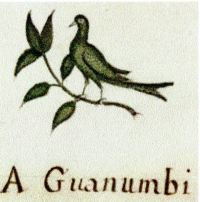
Richard Ligon was 60 years old when he shipped out to Barbados in 1647. A fugitive of the upheavals that vexed and troubled Englishmen during the sixteenth century, Ligon recently had lost what capital he had on a drainage project in Lincolnshire (Cahill 1) when a ‘Barbrous Riot,’ probably composed of Roundhead sympathizers, confiscated his land. Apparently Ligon had managed to establish some tenuous Court connection and so found himself, however peripherally, on the losing side of the Civil War. He had become, he wrote, “a stranger in my owne Countrey” who was “stript and rifled of all I had, left destitute of subsistence, and brought to such an Exigent, as I must famish or fly…. ” (Ligon 1)
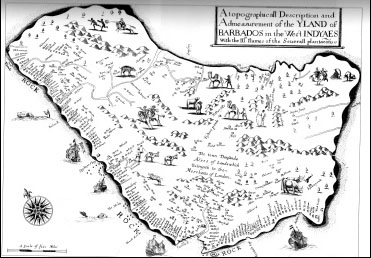
His prospects never had been good, for although he belonged to the gentry and may have studied at Balliol, Oxford, Ligon was “the fourth son of a third son” and so inherited “a respectable name but diluted fortune.” (Parker 39-40) He did acquire enough money to travel the continent, but there is no record of a wife or children.
2. A man of many talents.
Ligon was either fleeing his creditors, seeking a fortune late in life or both, and his travails have been our gain. It is unclear what precisely he had intended to do once he arrived in the Caribbean. Ligon spent three years there and something that he did wind up doing was write one of the first and best ‘essays on mores’ ever published. (No Peace 153; “a very early and excellent example of the essai sur les moeurs”)
He did other things as well, for Ligon was nothing if not a polymath. In the judgment of the estimable Carl and Roberta Bridenbaugh, he was the “best informed gentleman, architect, and engineer who ever went out to any of the English plantations in the seventeenth century.” (No Peace 39) They are effusive about him:
“Richard Ligon demonstrated beyond all doubt that he was the true Renaissance man in capacity, knowledge, in spirit and action. In fact it would be difficult to discover among the colonists of any other nation in the New World throughout the seventeenth century a more cultured individual.” (No Peace 151)
He was even more than all of that. His “knowledge of ship-handling and navigation, and of animal husbandry,” not to mention cartography, horticulture and music, was extraordinary. Ligon also “was exceptional for his interest in diets, good eating, and wide knowledge of how to prepare and cook foods.” (No Peace 47, 151n38)
It is this interest in food, and his wider experience on Barbados, that most interest us at britishfoodinamerica.
Ligon was resilient. He suffered terrible illness stemming from some tropical disease while living on Barbados, yet pursued all of these interests with the energy of a youthful tyro. Upon his return to England from the Caribbean, Ligon was clapped into prison as the guarantor of a defaulting debtor, where he wrote his celebrated ‘essay,’ A True & Exact History of the Island of Barbados Illustrated with a Mapp of the Iland, which was first published in 1657, when he was seventy. According to Matthew Parker, who is hardly uncritical of the seventeenth century cane economies, it is “by far the most vivid, sophisticated and considered contemporary account we have of these crucial, transformatory [sic] early years of the Sugar Revolution.” (Parker 39)
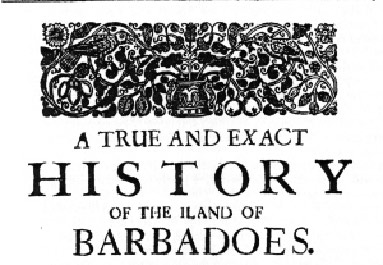
3. Man alive.
If he was no freebooter or amoral gold digger, Ligon was no desiccated survivor either, and no acolyte of the conventional. He must have been good company, and must have cut a singular figure on an island with a life expectancy considerably lower than forty years.
Parker is justified in claiming that Ligon’s History “shares the sense of wonder and excitement shown by every first-time visitor to the West Indies,” but in this case the thrill lasted past arrival for the entire stay. Ligon displays so much curiosity and generosity about everything he encountered that it is hard not to believe he felt the same way wherever he found himself. His description of the Cape Verde Islands, for example, and especially the beauty of its women, is as heartfelt and enthusiastic as anything he wrote about Barbados. (Parker 40; Ligon 8-18)
4. Matters of class.
His vivid History bustles with anthropological insight. Ligon divided the inhabitants of Barbados into three distinct groups, planters, servants and slaves. By the time he arrived on the island after only its second decade of settlement, a dearth of land and the difficulty of subsistence farming already had forced most of the middling and poor free whites offshore.
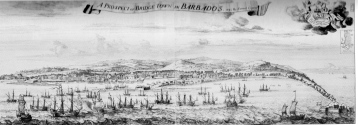
He was a subtle analyst. An admirer of the great planters and their considerable economic achievement against prohibitive odds, Ligon also deplored the condition in which many of them kept their indentured servants and slaves. Much has been made of his observation that in general the planters treated their slaves better than the servants, and much of it is anachronistic.
Hugh Cahill at King’s College London, for example, claims that Ligon contradicts himself, based on his observation that slaves were sufficiently miserable to “make it an ordinary practice, upon any great fright, or threatening of their Master, to hang themselves.” (Cahill 3 citing Ligon) From this Cahill concludes that “the conditions and treatment of slaves seem to have been worse. They often seem to have been in despair…. ” (Cahill 3)
If, however, we examine what Ligon himself wrote instead of speculating, inconsistency is not so apparent. The slaves, “being subject to their Masters forever, are kept and preservd with greater care than the servants, who are theirs but for five years…. So for the time, the servants have the worser lives, for they are put to very hard labour, ill lodging, and their dyet very sleight.” (Ligon 43) Three centuries later, the Penn historian Richard Dunn awkwardly seconds Ligon’s judgment: “The blacks in these early days of sugar production probably did receive better treatment than later.” (Dunn 229)
Nothing in the History contradicts any of this. Ligon is not discussing either the morale or the broader mental health of the slaves in claiming worse conditions for the servants, and the behavior he describes makes economic sense. However awful the diet of the indentured had been, hope is a valuable nutrient that was denied the slaves, and despair at perpetual bondage may be even more powerful a toxin. If Barbadian slaves may have been marginally better off materially, that does not mean that their holistic condition was not worse.
5. Manners of dress.
Another argument that Parker advances in opposition to Ligon’s conclusion about the relative condition of servant and slave relies on his calculation indicating that it cost planters more to clothe the servants. That statistic may not, however, carry much significance. Richard Dunn for one has observed that “[u]nfortunately” the English arrived in the Caribbean “during a period when extreme overdressing was popular at home.” Excess clothing signalled greater social position in a culture obsessed with status, so “only the rich and ambitious colonists overdressed. Consequently the island elite probably suffered more from the humid heat than their servants and slaves.” (Dunn 281, 282, 286)
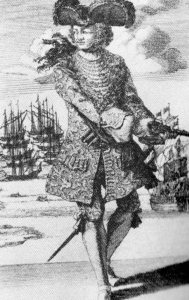
A hot guy
Dunn notes, however, that servants wore more than slaves and added that servants suffered more in the heat, presumably due to cultural notions of ‘decency’ and a desire for the trappings of ‘home.’ We know from Ligon and other writers that the Arawak generally refused clothing for good reason, and the Africans likely followed suit. “Unencumbered by layers of sweat-drenched clothing,” as Dunn infers, “the slaves probably kept cleaner than the white servants, and since they liked to wash more than Englishmen thought necessary in the seventeenth century, they very likely kept cleaner than their white masters.” (Dunn 284)
In other words, an element of choice applied to the clothing of the three classes that Ligon identified on the island. And indeed, Sir Hans Sloane wrote more generally of the English islands that “the Europeans do not well, who coming from a cold Country, continue here to Cloth themselves after the same manner as in England, whereas all Inhabitants between the Tropics go even almost naked, and Indians and Negroes go almost so here.” (cited at Dunn 286) They must have thought the English daft.
6. Matters of race.
Parker believes that Ligon “shied away from detailing cruelty to blacks,” and that in his “largely benign description of slavery” Ligon “refused to face the implications of his own evidence, for instance about slave suicide.” (Parker 61) He also labels Ligon “condescending and obviously racist,” which, because we are dealing with seventeenth century sensibilities, would appear to belabor the obvious, although in defense of Parker, he is a popular historian and therefore unwilling to risk too much detour from popular preconceptions.
The more interesting question would appear to be whether Parker is fair, and he is not. There is a fundamental problem with Parker’s narrative: He distorts the record. When, for example, Ligon explains why the slaves did not massacre their masters, his account is anything but condescending. Africans are not characterized as lacking in initiative or as otherwise inferior, but rather fettered by three disabilities. They never may handle weapons; the conditions of enslavement so severe that “their spirits are subjugated to so low a condition, as they dare not look up to any bold attempt;” and they speak so many African languages that “one of them understands not another.” (Ligon 46) It would be fatuous to consider any of this either race based or inhumane; it is Ligon, after all, who has told us of the sad suicides.
Parker turns this analysis upside down to claim that Ligon considered the absence of rebellion “‘a strange thing’” and even argues based on the same citation that Ligon “had been amazed that Barbados’ enslaved Africans… did not simply use their superior numbers to sieze control of the island” (Parker 65, 149) when, in fact, Ligon offers his reader the three explanations to “take away this wonder” that he explicitly says “has been accounted a strange thing” only by others. (Ligon 46)
In a particularly galling passage, Parker holds Ligon to account because “he contributed to the formation of racial stereotypes.” This untenable claim is supported by the observation that Ligon’s “is the first recorded use of the word ‘Pickanninney’[sic] to describe a black infant.” (Parker 61) That description, however, is the result of observation rather than innovation; in the History, Ligon quite clearly states that it was the slave mother on Barbados, not the English, who referred to her newborn as a “Pickaninnie.” (Ligon 48) Parker or his editor at least ought to have got the spelling right; perhaps neither of them actually read the History itself.
Parker compounds his crimes of anachronism by misciting Ligon once again in the same paragraph. “[H]is suggestions that the ‘Negroes’ were ‘a happy people, whom so little contents’ would,” according to Parker, “become a stereotype of blacks in America.” (Parker 61) Ligon did not, however, describe “a happy people;” instead, he described some individuals who were momentarily happy on their day off from punishing fieldwork, and that was “a lovely sight.” (Ligon 44) Moreover, as Dunn and other historians have noted, the seventeenth century English planters in the Caribbean displayed no compulsion to stereotype their slaves, or otherwise justify slavery; they accepted the institution as a matter of course. It is ludicrous to pillory Ligon for what ‘would,’ unrelated to his worldview, happen a century later.
7. Ligon and some ladies.
Parker, however, is not alone in his absence of historiographical acuity. Dunn, a more rigorous scholar, is snide in explaining that Ligon ‘charitably’ wrote that the breasts of some slave mothers were so distended that when they bent over that “you would think they had six legs.” (Dunn 252) Other English observers noted the same thing, but only Ligon explained why; his interest was anthropological rather than voyeuristic let alone ‘uncharitable.’ He explained that “the reason of this is, they tie the cloaths about their children’s backs, which comes upon their breasts, which by pressing very hard, causes them to hang down to this length.” (Ligon 51) Slave mothers literally labored under the weight of their babies. (Ligon 48)
Those beautiful women in the Cape Verdes also were black, and Ligon found nothing inferior about their manner, conversation or appearance; indeed, he was captivated by their company. The same is true about Ligon’s perception of the Amerindians; he thought the fine physiques of the Arawak reflected the ideal proportions established by Durer.
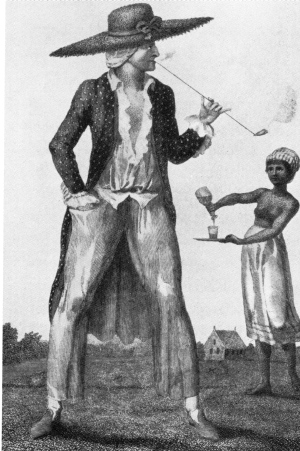
And lucky Ligon: A slave named Yarico assigned to him by his employer “was of excellent shape and colour, for it was a pure bright bay; small breasts, with the nipls of a porphrie colour, this woman would not be woo’d by any means to wear Cloaths.” (Ligon 54) From this, the Bridenbaughs note that Ligon contributed to “the gradually emerging conception of the Indian as a noble savage.” (No Peace 153)
As noted, Ligon considered the “handsome Negroes, men and women” alike on Barbados, “a lovely sight” and also had some undeniably good things to say about them. (Ligon 43) They were hard workers, accomplished musicians and “[e]xcellent swimmers.” (Ligon 52, misquoted by Parker)
8. Particular people.
Parker finds these observations contradictory because, he says, Ligon writes that “as a people the blacks were cruel and false,” (Parker 60) but in context the History instead reflects that subtle mind pushing back against the conventional wisdom of the age. Of course Ligon was racist, but it was a shallow racism that looked beyond dogma. As Parker does admit in less anachronistic mode, “Ligon was too intelligent and sensitive an observer to miss the darker side of life and death on the island” but the concession is rare. (Parker 43)
In fact Ligon does not refer to blacks as “a people” in the passage that Parker purports to quote, but rather describes “these people” whom he actually knew, and his usage is important. Ligon writes of the slaves’ “cruelties when they have advantages, and of their fearfulnesse and falsnesse; yet no rule is so general but hath his acception.” (Ligon 53) After all, these people were enslaved and therefore bound by human nature to direct such behavior at their tormentors. Furthermore, Ligon’s English contemporaries said considerably worse things about another ‘race,’ the French. Finally, the detrimental references to Africans that have attracted so much print fill but a handful of lines in the 122 page History.
Repeatedly in the History Ligon enters a plea on behalf of the Africans. He declares “that there are as honest, faithful, and conscionable people amongst them, as amongst those of Europe, or any other part of the world.” (Ligon 53) Elsewhere, in an allusion to received wisdom about the slaves, Ligon’s characterization sounds almost defiant and, also, tinged with regret:
“Let others have what opinion they please, yet I am of this beliefe; that there are to be found amongst them, some who are as morally honest, as Conscionable [there it is again], as humble, as loving to their friends, as loyall to their Masters, as any under the sunne, & one reason they have to be so, is, they set no great value upon their lives;” this latter only, we believe he infers, because of the tragedy of their bondage. (Ligon 54)
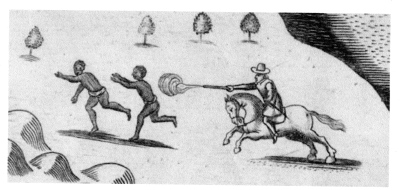
Ligon’s drawing of a slave chase
Lest anyone foolishly ascribe this admiration for loyalty exclusively to enslaved Africans, the concept hierarchy, of fealty to superiors, was integral to the theory of society not just during the Middle Ages but also into the Restoration and beyond.
9. An unusual friendship.
Ligon’s ‘beliefe’ arose in typically English manner, from empirical observation rather than theoretical deduction, for Ligon worked closely with slaves on the land. Several historians believe that Ligon’s friend Sir Thomas Modyford provided him with employment as well as hospitality, or benignly extracted the one in exchange for the other, and Ligon himself explains in the History that he “was imployed sometimes upon publique works,” which included the cutting of trails through what remained of Barbadian forest. (Ligon 49)
During one such project he worked with a slave called Sambo (no letters of protest please, it was his name) and even Parker concedes, if grudgingly, that “[t]here seems to have developed between the two men something akin to friendship, however unequal.” (Parker 60) Ligon unsuccessfully lobbied Sambo’s master to allow the slave’s conversion to Christianity and “was struck mute” for “poor Sambo… ; as ingenious, as honest, and as good a natur’d poor soul, as ever wore black, or eat green.” (Ligon 49)
10. Ligon, or, the gentleman-architect thwarted.
Ligon did considerably more than clear brush for the planters. He found their houses not only decrepit, but also unsuited to the climate. Ligon therefore rendered some twenty different plans for houses fitted with removable storm shutters and ventilated by the prevailing trades. As the Bridenbaughs point out, Ligon had produced “ingenious specifications” for radical housing forms: “Applying what he had learnt about building in France and Italy to the tropical scene, he produced designs that are still in use today.” (No Peace 134)
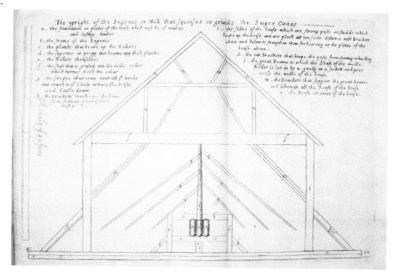
The History includes descriptions of several house plans. In one of them, Ligon explains how to site the house for protection from the heat of the sun:
“I would have a third part of my building to be of an East and West line, and the other two thirds to crosse that, at the West end: in a North and South line, and this latter to be a story higher than that of the East and West line, so that at four a clocke in the afternoone, the higher buildings will begin to shade the other, and so afford more shade to my East and West building till night… ” (Ligon 42-43)
The siting and proportion of his elevations were not Ligon’s only solution to the equatorial heat:
“I would raise my foundation of that part of my house wherein my best rooms were three foot above ground & leaving it hollow underneath for Ventiducts, which I would have come into every room in the house, and by that means you shall feel the cool breeze all the day & in the evening, when they slacken, a coole shade from my North & South building, both which are great refreshings, in hot Countryes.” (Ligon 43; the History includes the description of another plan at 103-04)
Most of Ligon’s plans, however, remained unexecuted during the seventeenth century by planters whom, he complained, “did not or would not understand them.” (Ligon 42) The Barbadian grandees remained imbued with traditional notions of display no less than their counterparts in England, and ignored tropical conditions, not to mention considerations of comfort or practicality, in their rush to replicate grand English models. (Parker 76-77)
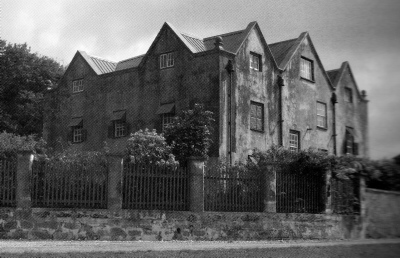
No ventiducts please, we’re English: Drax Hall, Barbados ca. 1650
11. A digression on musicke, or, Barbados could have been the birthplace of jazz… in 1649.
Ligon loved music, and hoped to lure musicians who played at a Blackfriars concert hall to Barbados. He knew them personally, and had canvassed his planter friends to pay them enough to keep them in style on the island, but the plan was one of the few that Ligon failed to realize due to his recurring illnesses. (Ligon 107; No Peace 152)
For our purposes, however, it is Ligon’s receptivity to African polyrhythm that matters most. At a time when other Englishmen “disliked the rackets they made” (Dunn 250), he writes of the slaves that
“they have their musicke, which is of kettle drums, and those of several sises; upon the smallest the best musician plays, and the others come in as Chorasses: the drum all men know, has but one tone; and therefore varietie of tunes have little to doe in this musick; and yet so strangely they varie their time, as ‘tis a pleasure to the most curious eares…. ” (Ligon 48)
As the Bridenbaughs understood, these polyrhythms “fascinated Ligon, who recognized their musical import. Certainly he was one of the first Europeans to sense this…. ” (No Peace 152) This must rank as one of the more astonishing artistic insights of the seventeenth century, for Ligon had grasped a fundamental of African music and was outlining an incipient theory of… jazz.

12. Flora, fauna and food.
Ligon was not only a good draftsman, but also a cartographer; it is his own “mapp” that appears in the History, and he has rendered the geography of Barbados with great accuracy and considerable charm. The illustrations that embellish the map, of fish and ships offshore, cattle and camels and boars, a slavemaster chasing runaways, armored horsemen and an Arawak holding his bow, are delightful. Ligon also was a skilled watercolorist who depicted with detailed accuracy the strange animals and plants of the tropics. They fascinated him: The “Palmeto Royall” was a particular favorite.
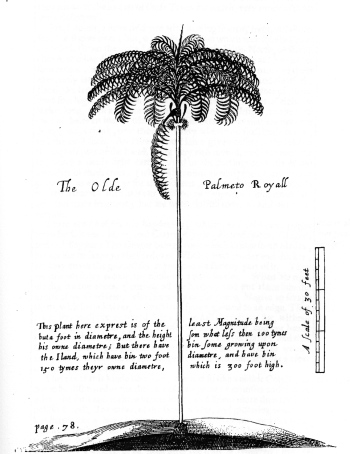
Ligon’s portrait of a Palmetto Royale
He brought with him all manner of herbs and other plants from England, succeeded in growing them in the strange climate, and also pioneered for Europeans and Africans alike the use of foodstuffs indigenous to the islands. “Of his many contributions to bettering West Indian life, Ligon’s “almost single-handed accomplishment in aiding both the whites and blacks to adjust their tastes to New World foods was,” as the Bridenbaughs maintain, “the greatest and most lasting, and what he imparted to the Barbadians was quickly picked up by the planters of the other islands.” (No Peace 49-50) An exception to the reluctance to taste ‘foreign’ food was the tropical fruit, which the English enthusiastically consumed from the outset.
Ligon learned to bake bread from corn and cassava and, from an elderly Arawak woman, how to grind cassava sufficiently fine to fashion piecrust. (Ligon 29-30) By 1650, when he returned to England, Ligon could report that “there was greater plenty… of the victuals they were wont to eat, as [sweet] potatoes, Bonavist [a species of bean], Loblolly [cornmeal porridge]…. ” (Ligon 37) He did not exaggerate this transformation of foodways on Barbados and beyond; according to the Bridenbaughs, primary sources corroborate his account of the Caribbean diet at midcentury. (No Peace 49n23, citing Harlow)
Ligon’s knowledge of animal husbandry increased the size of domestic pigs on the island, and he insisted that they produced “the sweetest flesh of that kinde, that ever I tasted.” Ligon himself further adapted to local conditions by seasoning pork pies with “kill-devill,” or rum. (Ligon 33-34)
Upon arrival at Barbados, Ligon had found the cooking of even the grander planters rudimentary and set out to improve it:
“I gave them some tastes of my Cookery, in hashing, and fricaseing this [pork]; and they were all much taken with it; and in a week, every one was practicing the art of Cookery.” (Ligon 34)
His students included tavernkeepers at the port, The Indian Bridge (latterday Bridgetown), who received tutelage in cooking seafood with vinegar and spice, or fried in oil (butter was of poor quality, and from Ligon’s description rancid, if there was butter at all) for service hot, “and some marinated, and sous’d in pickle, and eaten cold.” Fresh fish was a treat for the planters inland, for it spoiled so fast in the tropical heat that they could not transport it to their estates. Ligon’s pupils at the Bridge personified a solution, “and thither the Planters come, when they have a mind to feast themselves with fish.” (Ligon 35)
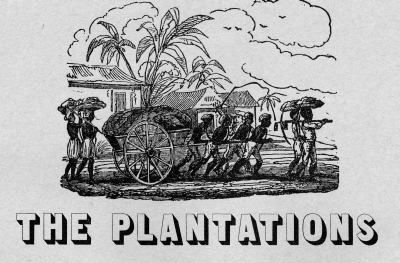
From a humanitarian perspective, Ligon’s best if not lasting achievement may have been the ability to convince “many of the planters of the real benefits arising from feeding their servants and slaves some meat and salt fish to balance their rations of loblolly and plantains.” (No Peace 49, see 49n23, Ligon 113) Malnourished workers are not only inefficient workers, they also are miserable and doomed, and Ligon doubtless was aware of both considerations in urging their masters to give them some meager measure of comfort.
Historiographical note:
Ligon’s History remains an excellent, even timeless work of anthropological analysis over three and a half centuries after its publication. It is all the more impressive when measured against the work of other early historians of the islands. A Short History of Barbados, for example, written by George Frere in 1768, includes nearly no analysis nor insight, and tells its reader nothing about the lives lived on the island. It would be no exaggeration to claim that Ligon’s consideration of early Barbados remained unequalled until the late twentieth century. It is more, however, than good focused history; it deserves a place in the canon of great nonfiction.
Retail note:
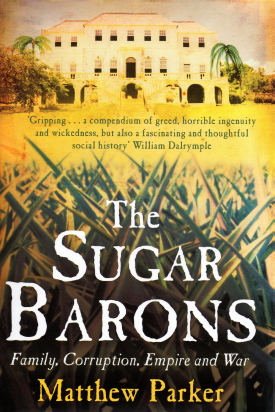
Skip The Sugar Barons in favor of the Bridenbaughs’ No Peace Beyond the Line. It is serious history, free of the anachronism and inaccuracy that mars The Barons, but is so well written that it reads like an adventure story. No Peace also demonstrates an acuity of analysis seldom found in any field, and besides, The Barons offers little that is new.
Dromedarian note:
There really were camels on Barbados in 1647. (Ligon 58; No Peace 90, 93, 97)
Sources:
Carl & Roberta Bridenbaugh, No Peace Beyond the Line: The English in the Caribbean 1624-1690 (New York 1972)
Hugh Cahill, “Book of the Month-September 2007,” www.kcl.ok/iss/learn-exhib/spotlight/archive2006-7/lig.html
Richard Dunn, Sugar and Slaves: The Rise of the Planter Class in the English West Indies, 1624-1713 (New York 1972)
Vincent Harlow (ed.), Colonising Expeditions to the West Indies and Guiana, 1623-1667 (London 1925)
Richard Ligon, A True & Exact History Of the Iland of Barbados, Illustrated with a Mapp of the Iland (London 1657; EEBO Editions facsimile printed 2011)
Matthew Parker, The Sugar Barons: Family, Corruption, Empire and War (London 2011)

